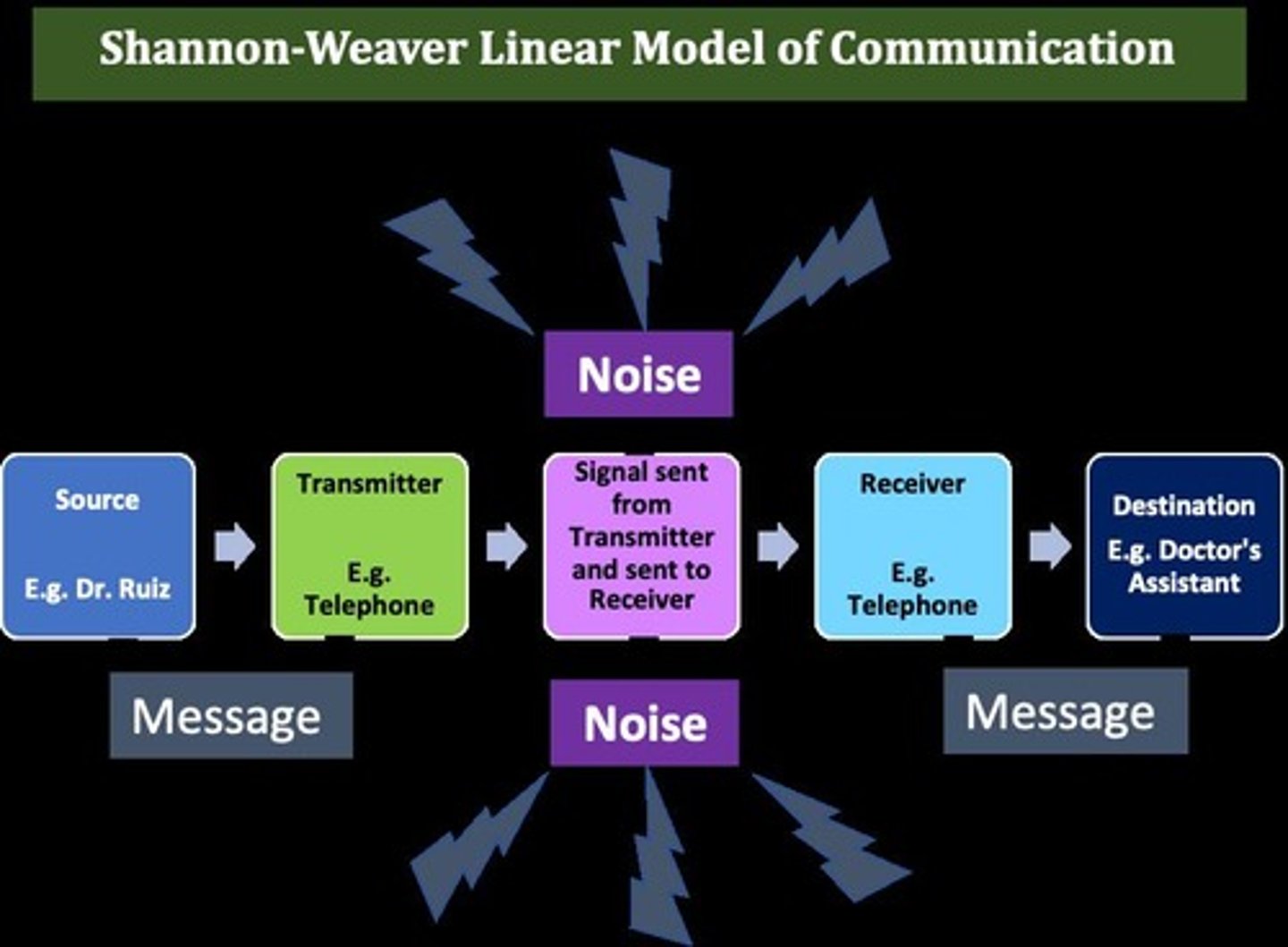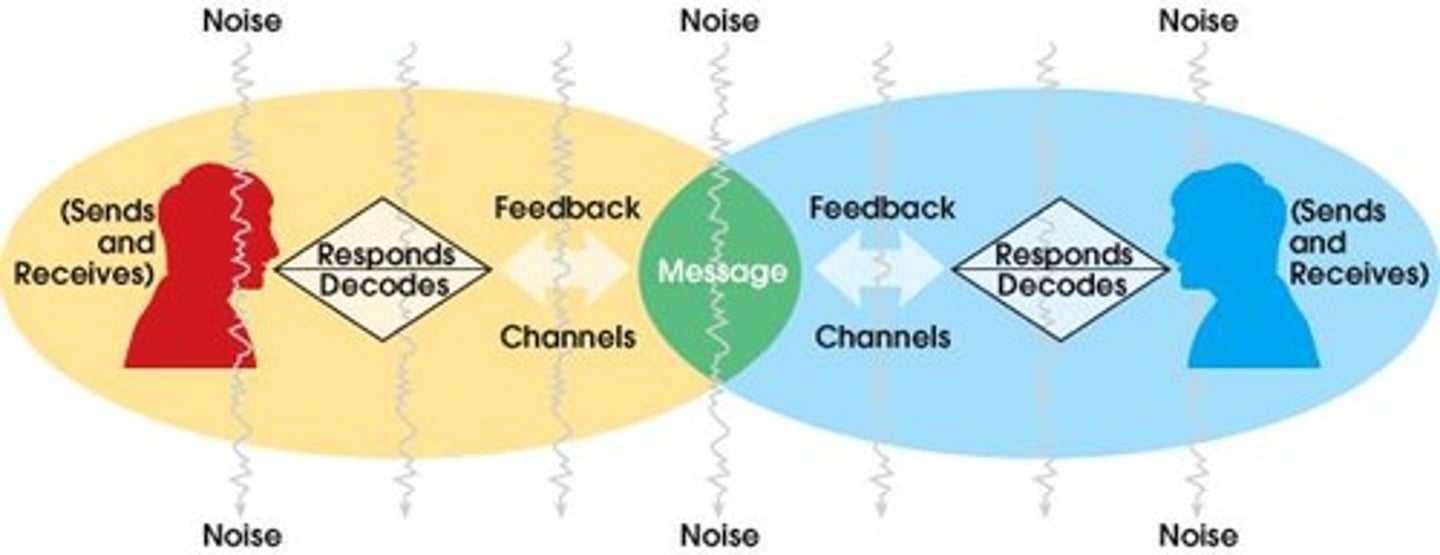Introduction to Public Speaking and Communication Models
1/393
There's no tags or description
Looks like no tags are added yet.
Name | Mastery | Learn | Test | Matching | Spaced |
|---|
No study sessions yet.
394 Terms
Communication
The sending and receiving of messages.
Transactional Model of Communication
A model where messages are exchanged simultaneously between sender and receiver.
Shannon-Weaver Model of Communication
An early linear model of communication that is one-directional, moving from sender to receiver without immediate feedback.

Nonverbal Communication
Communication that includes appearance, eye behavior, kinesics (body movement), proxemics (use of space), touch (haptics), time, and smell.
Elements of Transactional Communication
Components that facilitate the exchange of information through the assignment of meaning.
Axiom of Communication
One cannot not communicate; every verbal and nonverbal response is a form of communication.
Feedback
The response from the receiver back to the sender in the communication process.
Context of Communication
The circumstances or setting in which communication occurs, influencing how messages are sent and received.
Public Speaking
The act of delivering a speech to a live audience.
Communication Process
The series of steps involved in sending and receiving messages.
Verbal Communication
The use of spoken or written words to convey messages.
Kinesics
The study of body movement as a form of nonverbal communication.
Proxemics
The use of space in communication, including personal space and distance between individuals.
Haptics
The study of touch as a form of nonverbal communication.
Silence in Communication
A form of communication that conveys messages without words.
Eye Behavior
The use of eye contact and movement as a form of nonverbal communication.
Time in Communication
The perception and use of time in communication, influencing how messages are interpreted.
Smell in Communication
The use of scent as a form of nonverbal communication.
Preparation for a Speech
The ten steps involved in getting ready to deliver a speech.
Audience Engagement
The interaction between the speaker and the audience during a speech.
Message Encoding
The process of turning thoughts into communicable messages.
Message Decoding
The process of interpreting and understanding received messages.
Communication Barriers
Obstacles that hinder effective communication.
Effective Communication
The successful exchange of messages where the intended meaning is understood.
Sender
The originator of the message; in public speaking, this is the speaker.
Receiver
Anyone who hears or sees your message; in public speaking, this is your audience.
Encode
Converting ideas, thoughts, and feelings into words or actions.
Decode
Where the receiver interprets words or actions into meaning.
Denotation
The literal or dictionary definition of a word.
Connotation
The personal, social, cultural, or emotional association the receiver has with the message.
Message
The main idea(s) the sender conveys to the listener.
Channel
The medium through which the message is sent from the sender to the receiver; can be auditory and/or visual.
Noise
Anything that interferes with the message being encoded or decoded.
Physical noise
Interference from external sounds, such as people talking or papers rustling.
Physiological noise
Interference from internal physical state, such as hunger, illness, or pain.
Psychological noise
Interference from wandering thoughts, such as worries about homework or work.
Semantic noise
Interference from misunderstood meanings, such as cultural differences in gestures.
Context
The situation that influences the speaker, audience, and message.
Frame of Reference
The lens through which you view the world that informs how we encode and decode messages.
Speaker
The person who sends a message to the audience.
Audience
Listeners who are actively involved in receiving the message from the speaker.
Socio-psychological context
The relationship between the speaker and the audience.
Temporal context
Time of day and where the speech fits into the sequence of events.
Cultural context
The collection of beliefs, attitudes, values, and ways of behaving shared by a group of people.
Delivery
The methods used to send the message to the audience.
Impromptu
A method of delivery with little to no preparation, such as a spur-of-the-moment toast.
Memory
A method where the speaker memorizes a speech and delivers it exactly as rehearsed.
Manuscript
A method that involves a word-for-word iteration of a written message.
Extemporaneous
A method where presentations are researched, prepared for, and rehearsed, typically used in college classrooms.
Ethics
The obligation of both the speaker and the audience to be credible, truthful, respectful, and good listeners.
Determine your audience
The first step in preparing a speech, focusing on who you are speaking to.
Select your topic
The second step in preparing a speech, identifying your general and specific purpose.
Develop your thesis
The third step in preparing a speech, focusing on the central idea.
Research your topic
The fourth step in preparing a speech, gathering supporting materials.
Preparation outline
An outline that builds and supports main points using an organizational pattern.
Consider your use of language
The sixth step in preparing a speech, relating language to audience, ethics, topic, and occasion.
Construct your introduction, conclusion, and transitions
The seventh step in preparing a speech.
Finalize your preparation outline
The eighth step in preparing a speech.
Create your speaking outline
The ninth step in preparing a speech, including presentation aids.
Practice your speech delivery
The tenth step in preparing a speech.
Linear Model
A one-way communication model where a sender transmits a message to a receiver.

Socio-psychological
Referring to the social and psychological factors that influence communication.
Transactional Model
A communication model that emphasizes the simultaneous sending and receiving of messages.
Ethical Standards
Guidelines that determine speech goals to ensure the audience is receptive.
Authenticity
The quality of being genuine and truthful in speech content, which builds credibility.
Credibility
Your authority on a subject and your currency as a speaker, built through words and actions.
Inclusive Language
Language that aims to make all listeners feel represented and avoids excluding or disrespecting groups.
Plagiarism
Passing off other people's work as your own, which can have serious academic consequences.
Intentional Plagiarism
Purposefully using content that is not your own, such as stealing a speech or fabricating sources.
Unintentional Plagiarism
Inadvertently using someone else's work without proper citation.
Honest Messages
Messages that are truthful and do not deceive the audience, presenting verifiable facts.
Speech Goals
The objectives a speaker hopes to accomplish when addressing an audience.
Ethical Strategies
Methods chosen to achieve speech goals while adhering to ethical standards.
Guilt Induction
A method of persuasion that involves making someone feel guilty to achieve compliance.
Citing Sources
Giving appropriate credit for the sources used in a speech to avoid plagiarism.
Research Project
A task that involves gathering facts and evidence, requiring proper citation of sources.
Gender-Specific Terms
Words that may exclude or disrespect certain groups, such as 'man' or 'mankind.'
Bias in Language
Statements that express or imply ideas that are prejudiced or denigrating to particular groups.
Consequences of Plagiarism
Potential outcomes of plagiarism, including failing an assignment or being expelled.
Proper Paraphrasing
Rephrasing a source in a way that requires more than just changing a few words.
Audience Focus
The practice of prioritizing the audience's perspective and needs during speechmaking.
Verifiable Facts
Information that can be confirmed and is presented by ethical speakers.
Speech Content
The material presented in a speech, which should be original and properly cited.
Damaged Credibility
The loss of trust and authority due to dishonesty or bending the truth in speeches.
Ethical Speakers
Speakers who adhere to ethical standards and present truthful, researched information.
Ethical Responsibilities of the Listener
The obligations of an audience member to listen respectfully and attentively to a speaker's message.
Speech Preparation
The process of selecting and researching a topic, analyzing the audience, organizing main points, creating visual aids, and practicing delivery.
Impact of Speech
The effect a speaker's message has on the audience, which can be maximized through thorough preparation.
Active Listening
The practice of fully concentrating on what is being said rather than just passively hearing the speaker's words.
Open Mind
The willingness to consider new ideas and perspectives while listening to a speaker.
Body Language
Non-verbal communication through gestures, posture, and facial expressions that conveys attentiveness and respect in an audience.
Providing Feedback
The act of giving constructive criticism or praise to a speaker, which requires active listening and attention.
Quality Research
Thorough investigation and gathering of credible information to support a speech or presentation.
Visual Aids
Tools such as charts, graphs, or images used to enhance a speech and aid audience understanding.
Ethical Body Language
Body language that demonstrates respect and attentiveness towards the speaker, such as maintaining eye contact and nodding.
Distractions
Anything that diverts attention away from the speaker or the message being delivered.
Mindfulness in Listening
The practice of being fully present and engaged while listening to a speaker.
Audience Expectations
The assumptions and desires that a speaker has regarding how the audience will engage with their presentation.
Speech Delivery
The manner in which a speaker presents their speech, including tone, pace, and body language.
Respectful Listening
Listening to a speaker with consideration and attention, valuing their message and presence.